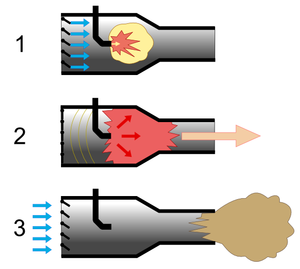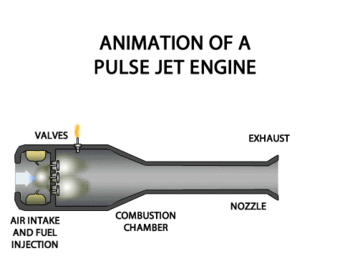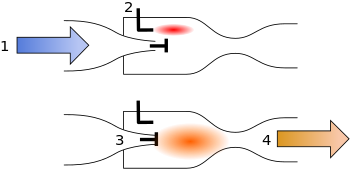محرك نفاث نبضي
| جزء من سلسلة عن |
| دفع الطائرة |
|---|
|
محركات عمود دوران: propellers الدافعة، الدوارات، ducted fans، أو propfans |
| محركات رد الفعل |
| غيرهم |
المحرك النفاث النبضي Pulsejet هذا النوع من المحركات هو أقدم نوع من المحركات النفاثة وأبسطها حيث هو عبارة عن محرك احتراق داخلي بسيط يحدث فيه الإحتراق على شكل نبضات. وهو على نوعين نوع على شكل U ولا يحتوي علي صمامات. والنوع الثاني خطي ويحتوي على صمامات.
وتتلخص فكرته في الآتي:
أن الهواء يدخل من فتحتين، ثم يختلط بالوقود وينفجر عن طريق المشعل، وعند الإنفجار تتولد طاقة دفع.
التاريخ
Russian inventor and artillery officer N. Teleshov patented a pulsejet engine in 1864 while Swedish inventor Martin Wiberg also has a claim to having invented the first pulsejet, in Sweden, but details are unclear.
The first working pulsejet was patented in 1906 by Russian engineer V.V. Karavodin, who completed a working model in 1907. المخترع الفرنسي جورج ماركونيه Georges Marconnet سجل براءة اختراع his valveless pulsejet engine في 1908، و رامون كازانوڤا، في ريپول، اسبانيا، سجل براءة اختراع pulsejet في برشلونة في 1917، having constructed one beginning in 1913. روبرت گودارد invented a pulsejet engine in 1931, and demonstrated it on a jet-propelled bicycle.[1] Engineer Paul Schmidt, pioneered a more efficient design based on modification of the intake valves (or flaps), earning him government support from the German Air Ministry in 1933.[2]
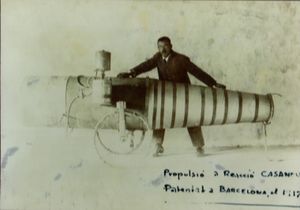
Argus As 109-014
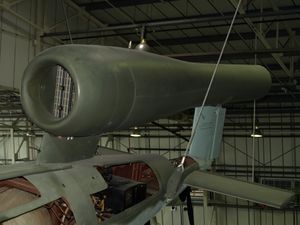
In 1934, Georg Madelung and Munich-based Paul Schmidt proposed to the German Air Ministry a "flying bomb" powered by Schmidt's pulsejet. Madelung co-invented the ribbon parachute, a device used to stabilise the V-1 in its terminal dive.[بحاجة لمصدر] Schmidt's prototype bomb failed to meet German Air Ministry specifications, especially owing to poor accuracy, range and high cost. The original Schmidt design had the pulsejet placed in a fuselage like a modern jet fighter, unlike the eventual V-1 which had the engine placed above the warhead and fuselage.
The Argus Company began work based on Schmidt's work. Other German manufacturers working on similar pulsejets and flying bombs were The Askania Company, روبرت لوسر of Fieseler, Dr. Fritz Gosslau of Argus وشركة سيمنز company, which were all combined to work on the V-1.[2]
التشغيل
الوظيفة
انظر أيضاً
الهامش
المراجع
- Aeronautical Engineering Review, Institute of the Aeronautical Sciences (U.S.): 1948, vol. 7.
- George Mindling, Robert Bolton: US Airforce Tactical Missiles:1949-1969: The Pioneers, Lulu.com, 200: ISBN 0-557-00029-7. pp6–31
وصلات خارجية
- - An international site dedicated to pulsejets, including design and experimentation. Includes an extremely active forum composed of knowledgeable enthusiasts
- - A site for hobby jet propulsion, specifically valved and valveless pulsejet engines. They offer many free pulsejet plans, and have a lot of useful information
- Video of 21st century-built German reproduction Argus As 014 pulsejet testing
- - A detailed guide documenting all the steps required to build one's own Pulsejet. The example created on this site is eventually mounted onto a home-built kart and tested
- Pulsejets in aeromodels
- Popular Rotocraft Association
- Pulsejet Bike
- Apocalyptic robotics performance group Survival Research Labs operates a collection of pulsejet engines in some of their creations, including the Hovercraft, V1, and the Flame Hurricane.
- PETA (Pulse-Ejector-Thrust-Augmentors) article
- Ramon Casanova's pulsejet
- American Helicopter XA-5 Flight
